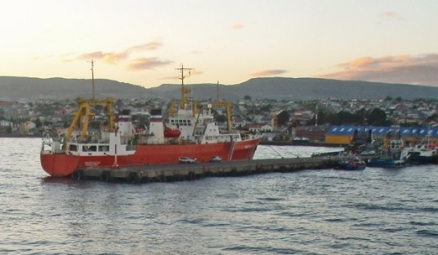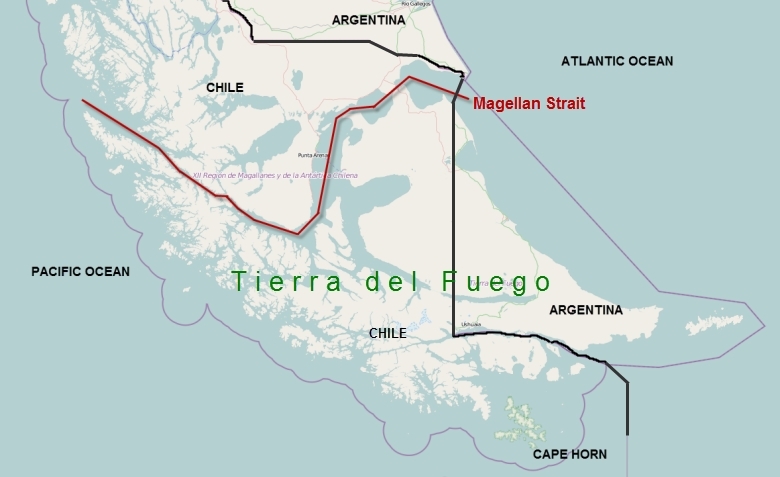Strait of Magellan
The Strait of Magellan is an oceanic passage generally connecting the Atlantic Ocean to the Pacific Ocean, situated in southern Chile and Argentina. The earlies European voyage from the Atlantic to the Pacific was Portuguese explorer Ferdinand Magellan, and his route, the Strait of Magellan, between the South American mainland and Tierra del Fuego is named for him. The Strait of Magellan is an approximately 500 kilometre long fully navigable oceanic channel. This water body is classified as a semi-enclosed periantartic ecosystem.
Over 13,000 years before present ancient peoples crossed the Strait of Magellan from the continent to establish settlements in Tierra del Fuego. In modern times the Strait of Magellan has suffered from episodic outbreaks of red and brown tide algalblooms, with associated mass kills of marine invertebrates and other species.
Contents
Hydrology and circulation
The Strait of Magellan connects the southern Atlantic and southern Pacific Ocean. On the Atlantic Ocean side, the Strait is epitomised by semidiurnal macrotides with mean and spring tide respective amplitudes of 7.1 and 9.0 metres. On the Pacific Ocean western side, tides are mixed, chiefly semidiurnal, with mean and spring tide swings of 1.1 and 1.2 metres, respectively. Expansive tidal flats and basin geometry amplify the Atlantic shelf tides in the eastern extreme of the Strait. Tidal choking occurs in a series of narrows, causing stepwise decreases in the tidal range from east to west.
Tidal forcing is a dominant factor in the Strait of Magellan as well as other Patagonian fjords and channels. Sills and other underwater topography also have a key influence in Magellan Strait circulation, effectively constraining significant circulation between major sill boundaries. For example at the Seno Ballena, there is a shallow sill only two to three metres deep, which is further enhanced with a Macrocystis kelp mantle, which effectively blocks landward saline flow, save for tide floods.
Water quality
Concentrations of nitrate and silicate are highly variable by season. In particular chain diatom blooms in the austral spring explain the dramatic seasonal reduction in both nitrate and dissolved silicate. Dissolved oxygen tends to be highest near glacial inflows, where the water is coldest.
The Strait of Magellan is the only locus in the southeast Pacific Ocean where extensive harmful algal blooms have been recorded. Since the second half of the twentieth century, observations have been made of episodic outbreaks, one of the earliest being a paralytic shellfish poisoning outbreak induced by Alexandrium catenella in 1972. In 1999 widespread occurrences of a brown tide were seen in Canal Abra, where large numbers of congers, sea stars, sea urchins, octopi and other invertebrates died and washed ashore.
Around the same time in 1999 brown tide blooms were noted at Punta Carrera and at Chiloe Island; in all of these 1999 occurrences alien species of the genus Gymnodinium were assigned the blame of the outbreak. It has been conjectured that these non-native species of Gymnodinium were transported to the Strait of Magellan via a large scale phytoplankton transport along the southeast Pacific coast (e.g. from the Chilean Pacific).
Marine ecology
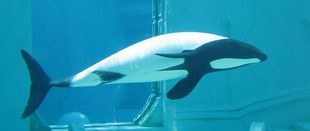 Commerson's dolphin is found in parts of the Strait of Magellan. Micro size primary producers that bloom in the fjords and channels of the Strait of Magellan are chiefly diatoms and dinoflagellates. Pico- (0.2 to 2 μm) and small (2 to 10 μm) nanophytoplanktonic assemblages have been studied in the Strait of Magellan, chiefly in portions of high fjord runoff areas and in an inland sea in the shallow eastern part of the strait known as Paso Ancho. Picophytoplankton abundance varies between 810,000 to 32,800,000 cells per litre; moreover, cyanobacteria counts are generally ten times higher than picoeukaryotes at the beginning of the austral autumn.
Commerson's dolphin is found in parts of the Strait of Magellan. Micro size primary producers that bloom in the fjords and channels of the Strait of Magellan are chiefly diatoms and dinoflagellates. Pico- (0.2 to 2 μm) and small (2 to 10 μm) nanophytoplanktonic assemblages have been studied in the Strait of Magellan, chiefly in portions of high fjord runoff areas and in an inland sea in the shallow eastern part of the strait known as Paso Ancho. Picophytoplankton abundance varies between 810,000 to 32,800,000 cells per litre; moreover, cyanobacteria counts are generally ten times higher than picoeukaryotes at the beginning of the austral autumn.
Picophytoplankton and nanophytoplankton accounted respectively for 46 percent and 27 percent of the total chlorophyll A, which displays a mean value of 0.32 μg per litre in the areas sampled by Vanucci; moreover, some of the highest chlorophyll values were exhibited in the northern parts of Paso Ancho.
Phytoplankton biomass generally is measured to lie between 10 and 51 milligrams (mg) per square metre, and primary production ranges between 275 and 1170 mg chlorophyl A per square metre per day.The assemblage of marine plant pigments suggests the elevated concetrations of phytoplankton pigments and production are probably attributable to chlorophytes, prasinophytes, prymnesiophytes or Gyrodinium and Gymnodinium-like dinoflagellates that were submitted to natural senescence and to superfluous feeding activity; moreover, when diatoms, cryptomonads and prymnesiophytes dominate, efficient zooplankton grazing occurred and characterized a balanced food chain.
There are a considerable number of fishes as well as penguins and marine mammals that are found in the Strait of Magellan. Notable larger species occurring here are the Magellanic penguin (Spheniscus magellanicus), humpback whale (Megaptera novaeangliae) and Commerson's dolphin (Cephalorhynchus commersonii).
Terrestrial ecoregions
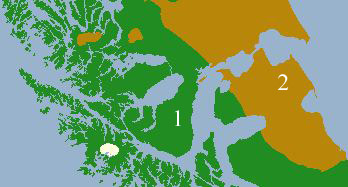 Ecoregions surrounding the Strait of Magellan. Source: WWF Two terrestrial ecoregions straddle the Strait of Magellan:
Ecoregions surrounding the Strait of Magellan. Source: WWF Two terrestrial ecoregions straddle the Strait of Magellan:
Magellanic subpolar forests exhibits two principal forest types of forest, evergreen Nothofagus betuloides forests to the west and deciduous Nothofagus pumilio and Nothofagus antarctica forests towards the east extending into Argentina. In Tierra del Fuego evergreen forests lie to the south, and deciduous forests toward the interior. The deciduous forest is comprised of pure Nothofagus pumilio at lower elevations, in different combinations with the more ecologically tolerant Nothofagus antarctica, which dominates in arid situations or less drained soils. In frost pockets a heath dominated by Empetrum and Bolax is found. In humid or wet places of these forests especially rich raised bog-communities grow dominated by Sphagnum, Juncaceae, Cyperaceae and grasses.
The deciduous Magellanic subpolar forest shows a transition to the evergreen forest to the west with mixed Nothofagus pumilio-Nothofagus betuloides forests. With approximately 1000 to 4000 millimeters of precipitation N. betuloides becomes dominant, forming pure forests or mixed with Drymis winteri, Maytenus magellanica and Pilgerodendron uvifera. Inland shrubs of Fuchsia, Ribes, Hebe, Gaultheria and Empetrum accompany, while in coastal situations Hebe elliptica forms a dense scrub. In the north Nothofagus dombeyi and N. nitida are found up to 48ºS, and Podocarpus nubigena to 51ºS.
In the colder areas of the Magellanic subpolar forests with high rainfall of the south western most parts of the ecoregion a characteristic vegetation specially termed Magellanic moorland or Magellanic tundra extends through the Chilean archipielago to 48ºS. This tundra is characterized by prostrate dwarf shrubs, cushion plants, grass-like plants and bryophytes on water-logged terrain that in different combinations form vegetation of scrub or [[bog]s]. In sheltered areas, even on the outermost islands, only fragments of the evergreen forest develop. The bogs comprise characteristic species, many with austral affinities such as Astelia, Bolax, Caltha, Donatia, Drapetes, Gaimardia, Lepidothamnus and Phyllachne.
In the [[Patagonian steppe] ecoregion] there are two endemic speciesof the genus Prosopis, one species of Larrea, as well as species of the genera Lycium and Schinus. Genera and species endemisms are quite frequent in this ecoregion, among them Philippiella, Neobaclea, Xerodraba, Benthamiella, Pantacantha, Saccardophyton, Duseniella, Eriachaenium, and Llepidophylum.
Prehistory
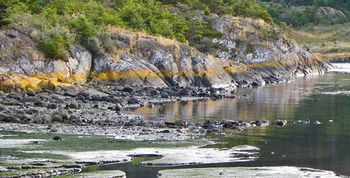 Tidal fishing area of prehistoric Yaghan people, Bahia Wulaia. Note that the stone fish traps have been rebuilt over millenia to accomodate sea level rise during the Holocene. @ C.Michael Hogan After crossing the ice bridge across the Bering Sea just before the beginning of the Holocene, these Siberian travellers arrived throughout the Americas, even as far as Patagonia by about 13,000 years before present. Some of these peoples were able to cross the Strait of Magellan about this time. (One should note that the sea level was much lower at that time, making the crossing distance much less.) Elaborate semi-permanent early Holocene settlements, such as that of Bahia Wulaia on Navarino Island, have been recorded in Tierra del Fuego south of the Strait of Magellan. These early settlers constructed elaborate stone wall fishtrips in the shallow bays, some works of which are extant today; there are also dome middens, whose geometry of living areas is clearly visible at the current time. The tall peoples of this early period here are known to have been excellent swimmers, with the women conducting most of the marine organism harvesting.
Tidal fishing area of prehistoric Yaghan people, Bahia Wulaia. Note that the stone fish traps have been rebuilt over millenia to accomodate sea level rise during the Holocene. @ C.Michael Hogan After crossing the ice bridge across the Bering Sea just before the beginning of the Holocene, these Siberian travellers arrived throughout the Americas, even as far as Patagonia by about 13,000 years before present. Some of these peoples were able to cross the Strait of Magellan about this time. (One should note that the sea level was much lower at that time, making the crossing distance much less.) Elaborate semi-permanent early Holocene settlements, such as that of Bahia Wulaia on Navarino Island, have been recorded in Tierra del Fuego south of the Strait of Magellan. These early settlers constructed elaborate stone wall fishtrips in the shallow bays, some works of which are extant today; there are also dome middens, whose geometry of living areas is clearly visible at the current time. The tall peoples of this early period here are known to have been excellent swimmers, with the women conducting most of the marine organism harvesting.
References
- S.D.Davis, V.H. Heywood, and A.C. Hamilton. 1997. Centres of Plant Diversity. A guide and strategy for their conservation. Volume 3: The Americas. IUCN Publications Unit. Cambridge, U.K. ISBN: 283170197X
- C. Michael Hogan (2008) Bahia Wulaia Dome Middens, Megalithic Portal, ed. Andy Burnham
- Emanuele Lodolo, Marco Menichetti, Roberto Bartole, Zvi Ben‐Avraham, Alejandro Tassone and Horacio Lippai. 2003. Magallanes-Fagnano continental transform fault (Tierra del Fuego, southernmost South America). Tectonics 22 (6): 1076.
- Carmen Medeiros and Bjorn Kjerfve. 1988. Tidal characteristics of the Strait of Magellan. Elsevier. Continental Shelf Research Volume 8, Issue 8, Pages 947–960
- V.Saggiomoa, A.Goffartb, G.C.Carradac and J.H.Hecq. 1994. Spatial patterns of phytoplanktonic pigments and primary production in a semi-enclosed periantarctic ecosystem: the Strait of Magellan. Journal of Marine Systems. Volume 5, Issue 2, Pages 119–142
- Rodrigo Torres, Maximo Frangopulis, Madeleine Hamame, Vivian Montecino, Costanza Maureira, Gemita Pizzaro, Brian Reid, Arnoldo Valle-Levinson and Jose Luis Blanco. 2011. Nitrate to silicate ratio variability and the composition of micro-phytoplankton blooms in the inner fjord of Seno Ballena (Strait of Magellan 54 degrees south). Continental Shelf Research. Elsivier. 31:244-253
- Juan Carlos Uribe and Milena Ruiz. 2001. Gymnodinium Brown Tide in the Magellanic Fjords, Southern Chile, Revista de Biologia Marina y Oceanografia. 36 (2): 155-164
- S.Vanucci and O.Mangoni. 2005. Pico- and Nanophytoplankton Assemblages in a Subantarctic Ecosystem: The Strait of Magellan.Botanica Marina. Volume 42, Issue 6, Pages 563–572, ISSN (Print) 0006-8055,
